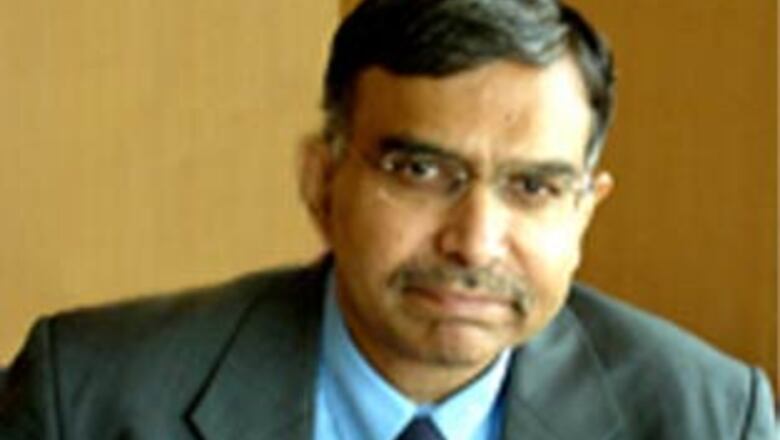
views
Wipro announced its Q4 results today reporting a net profit of Rs 1,011 crore and revenues of Rs 6,482 crore (Indian GAAP).
After announcing its results, Girish Paranjpe, ED and Joint CEO of Wipro sounded more optmistic than most IT giants.
He said from the outsourcing and global delivery perspective, the worst may be over. "I am not predicting the end of the recession, but all I am saying is from the outsourcing and global delivery perspective, it seems that many of the things that people were worried about seems to be easing. Unless some other mega crisis happens, I think we should be at a steady level and start to inch up rather than recede backward."
The management said the company was witnessing improvements in the business environment but added it doesn't rule out flat earnings growth in FY10. “We are entering FY10 with cautious optimism. We have made the right investments and expect our utilisation levels to increase in FY10."
The Wipro management who spoke to CNBC-TV18 include CFO and ED Suresh Senapathy, ED and Joint CEO Girish Paranjpe, ED and Joint CEO Suresh Vaswan and President of Wipro Consulting TK Kurien.
Wipro said it has not cut salaries yet but it could not rule out that possibility, adding that it would absorb all campus recruits given offers in FY09.
On telecom, the management stated that the slowdown in telecom was due to a 5-10 per cent drop in equipment demand and expects business from the telecom vertical to be better this year.
PAGE_BREAK
Here is a verbatim transcript of the exclusive interview with The Wipro management on CNBC-TV18. Also watch the accompanying video.
Q: What did you exactly tell the market about Q1 because you have guided a modest decline, can you just put us through what went into that Q1 guidance?
Senapaty: Q4 has been about $13 million better than what we had guided for as compared to many others who are closer to the low-end. I think we have successfully been able to push out any kind of a ramp downs or price reduction that was impending and from that point of view we are having good quarter so far. Therefore, we have been seeing an expansion in our margins significantly so far as Q4 is concerned and an expansion in our price realizations with offering of the cost discount, so far as the customers are concerned. Overall the quarter was good with growth numbers.
In Q1 there was a decline in terms of certain headcounts in Q4. So this full impact will be felt in Q1. Apart from that, from the financial services side, we had certain ramp downs and that would again be felt for full quarter and also on the technology side that will be fully felt. So for this we think Q1 is also fairly decent with a guidance of $1,009 to 1,025 million.
Q: From a business perspective should one extrapolate Q1 into the rest of the year or are there some aberrations because of which Q1 to Q4 is down or should one extrapolate that Q2-Q3, you are also looking at a modest decline?
Paranjpe: We do not give full year guidance but all I can say from a sense of the market perspective is that it seems like the worst maybe behind us and I am not saying that from an overall economy perspective but I am talking more from a client’s perspective. We see the order pipeline building up and it seems like many of the things which were hurting us in the last quarter and maybe some parts of this quarter may not again get repeated later on but I am pronouncing the end of recession.
Q: You are the first largecap CEO who is saying that the worst is behind us?
Paranjpe: I am not predicting the end of the recession but all I am saying is from our business, the kind of outsourcing and global delivery perspective, it seems that many of the things that people we very worried about seems to be easing and unless some other mega crises happens or something happens in environment, I think we should be kind of at a steady level and start to inch up rather than kind of recede backward.
PAGE_BREAK
Q: From now on because we have heard this note of optimism from some other companies but they say with the caveat that it won’t happen in the next two quarters, it will be back ended in Q3 and Q4. You are saying steady state things are improving?
Paranjpe: Improvement will start post-summer. There is a certain amount of optimism at this moment as compared to what the situation was even few months back.
Q: I know you are not giving guidance for the full year but do you have even a sense that you can share with the market on whether FY09 over FY08 will be a decline or will you at least be able to have a flat kind of a year over the year that went by?
Senapaty: For the very fact that we have a negative growth for Q1, to expect a growth rate for the whole of ’09-10 similar or better than ‘08-09 from a math perspective doesn’t work out well because you have to look at what the tailwinds and the headwinds are.
Q: I am saying FY09 to FY10 – can it be flat, same revenue, same profit?
Senapaty: At this point in time while we do not have a specific guidance but I do not think we can rule out a growth, we can rule out flat.
Q: From a domestic market point of view, the sign of optimism that Girish spoke about also reflected? Will that contribute to growth in FY10?
Vaswani: On the domestic market, last year was a great year for us; in rupee term we have actually grown 47 per cent YoY which is fantastic growth in today’s time. Going forward, the domestic market will slowdown or has with under slowdown but certainly we are setting our sites in terms of outgrowing the market. Traditionally, we have out grown the market two-three times which is what we have done last year and we hope to continue the momentum.
I think last year from a global perspective and from an overall IT services perspective it was a great year; we have grown ahead of the market at 18.5 per cent growth and if you translate that to constant currency that’s 22.5. We are going into next year or this year with what I would say a fairly good healthy pipeline and good healthy funnel across all the sectors.
So, just building on what both Girish and Suresh said that we are going in with a fair degree of optimism. Finally the results are going to depend upon how fast the deal is closed and how quickly we are able to ramp-up but a healthy funnel is a good sign to the beginning of the year.
PAGE_BREAK
Q: Can you share this optimism going into 2010 or is going to be challenging for Business process outsourcing (BPO)?
Kurien: The consulting business is a lead indicator for typically the kind of deal that are coming down the pike. Q3 was probably our worst quarter because we saw project cancellations and they were all immediate project cancellations, where people said let’s freeze up before the year end and that is what we saw. After that in the consulting business January was not too good a month, in February-March we have seen a significant pick up especially in the US and that to us is a very positive sign that things are going to be better as we go down the pike.
Q: Do other sector generally follow the lead of consulting?
Kurien: Typically, what happens is that its about 3-6 months ahead of actual business coming in and that is one indicator we have seen. So that is one reason why we are seeing some degree of optimism in the environment.
Q: Your peer Infosys says prices will go down 6% next year, you don’t seem to be so pessimistic about pricing?
Paranjpe: We managed to hold on quite well on the pricing side, although there has been some decline. I think what we have tried to do with clients is to get to a point where we are talking cost reduction to clients, rather than just discuss price.
Because at the end of the day the price is a small portion of what affects the client. If we can bring the cost down by 30-40 per cent either by automating some work or not doing some work at all or moving some work offshore that is much bigger benefit to clients, then just saying let me cut price by x percentage.
I think wherever we have been able to get into an adult conversation like that both clients have gained and we have gained - sometimes procurement is not always rational, so I also contend with that. So where we can’t always have that kind of conversations, then we have to discuss price and what happens to that and there are consequences of that happening.
Senapaty: You have seen the reflection of that in our fixed price projects have gone up over the last three quarters. With this as an exercise that we have always engaged in particularly from the go to market perspective, the delivery organization and solution perspective and therefore you have seen fixed price projects going up, you are seeing the productivity going up and customers saving money as they have targeted.
PAGE_ BREAK
Q: What happened with margins in Q4 and what era you building in, if this are the call on pricing, what are you building in for the Q1 and for the next year in terms of margins?
Senapathy: We don’t give guidance but clearly our focus is long term growth, investments to be long term growth and short term stability or margins, so we will not take our eyes off on the margin front and yet wanting to invest everything that we are able to generate and we have done very well so far as the cash flows are concerned, its down two days from Q3 to Q4, YoY down by about seven days and from that point of view we are focusing on cash not only for customers but also for ourselves.
Q: One niggling worry has been the kind of hedges that Wipro has which is a bit higher than some of its peers, now will you unravels that for FY10?
Senapathy: This has been the big reason why we haven’t got the significant benefit on the Forex in 2008-09 while many of our peers would have got the benefit and if you look at on a YoY basis, we did not have the benefit of more than 20 basis points on a net of cross currency point of view, so perhaps in FY09 and FY10 also we will have a much lesser favourable impact as the rupee depreciates. So therefore you could say that the other levers have been pulled to make sure that we are able to deal with the kind of pressures.
Q: Are you looking to change the strategy at all over the next four quarters?
Senapathy: We haven’t added on for the last few quarters and we have held on to it or reduced it as of March end versus the December end, there has been a reduction by about $400-500 million because we still think that in the shorter term there will be a time where the rupee could be going either way perhaps there is more opportunity for it to be depreciating and from that point of view we have reduced the hedge book as it stood as compared to the December end.
PAGE_BREAK
Q: What are your expectations from the BPO in FY10?
Vaswani: Last year, had been good for us on the BPO front, we have grown around 20 per cent year on year so that is good performance, the notable part about our BPO business last year is that our order booking has been significant, almost twice of what it was the previous year.
We have been able to get attrition also down quite substantially which is down now to around 50 per cent which is a significant movement so far as that number is concerned and we have driven our transaction processing business fairly significantly so that accounts for as much as 45 per cent of our total business, so all things going good on the BPO front.
Q: Are margins holding up?
Vaswani: Yes they are holding up, we are fairly steady as far as margins are concerned on the BPO front. One different in the BPO front particularly last year going forward is that we are working fairly closely on the IT teams, so there is a lot more BPO-IT integration both in terms of front end and account management as well as in terms of joint solutions between IT and BPO and that’s beginning to yield results
Q: What about recruitments and salaries? Times are tough, you are trying to control cost, will there be any increments this time around at Wipro?
Senapaty: So far as the onsite is concerned, on January 1, we pushed it out. So far as the offshore is concerned, it comes in for a review only in August-September.
Q: What looks likely from here?
Senapaty: If you look at the overall environment perhaps there are pressures and therefore you are not required to be doing any kind of a normal across the board increase at all.
Q: Will you think of cutting salaries, variable or fixed?
Senapaty: The variable component definitely is subject to do variations in both ways so from that point of view we have an internal set plan versus what we have achieved. It does get linked up on that basis. So far as the cut in salary etc is concerned, I think you can never say no but at this point in time we have not resorted to that as yet.
But all options are open depending upon how it pans out and I hope what we just now talked about in terms of a tone of optimism happens and we are never required to get into that kind of a situation.
PAGE_BREAK
Q: What about recruitment? Wipro has been very conservative with recruiting these last few quarters, given how business fundamentals are, are you still adopting a very cautious and conservative approach to recruitment for the next three-four quarters?
Vaswani: We are basically balancing recruitment with demand and that is what we have done last year. But there are two-three things that we have also done; we are going to be taking in all the offers that we had given in 2008 through 2009.
So this year we are basically going to take in all the campus recruitment offers that we had given last year. We are going to get them, we are going to train them and then based on the demand situation we will deploy them. One is taking in all the campus recruits that we had committed to, two is taking them in a phase manners so that we balance demand with the supply.
Q: Will there still be a significant bench you think, lower utilization levels than last year?
Vaswani: We have improved our utilization in the last year quite significantly and we plan to drive more operation excellence and more operation efficiency as we go into next year.
So the idea is to take all the operating efficiencies to the optimal level and that is what we are planning to drive. So we don’t anticipate utilization going down next year. We anticipate it going up.
Q: What is going on with telecom? I believe in this quarter too, revenues are down 12 per cent, is that right?
Kurien: What we are seeing in the telecom business is that in our equipment business our customers are finding a demand drop between 5 per cent and 15 per cent.
So obviously when they see that kind of a demand drop, the research & development (R&D) spend is being cut down. Having said that we see new opportunities coming up on the enterprise side of the house because still now what we were doing was we were selling to the R&D side of the shop and last year we started the big push towards the enterprise side.
Enterprise side is showing promise. We are also finding that other activities like Business Process Outsourcing (BPO) - we never used to kind of sell effectively in the past into that segment, it is now slowly picking up. So overall if you look at telecom as a segment, I think that this year it won’t be as bad as last year.
Q: Is it a volume issue out there or is it a pricing issue or both?
Kurien: It is a little bit of both, we are able to take a lot of the pricing issue and convert them into more cost issues rather than price issues.
Source: CNBC-TV18




















Comments
0 comment